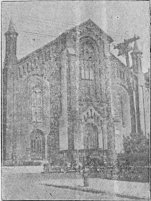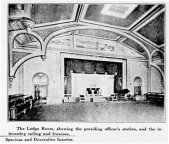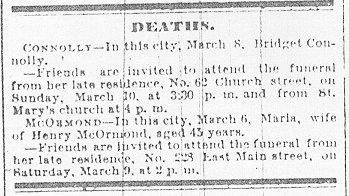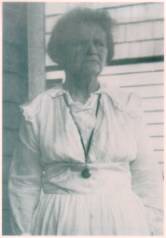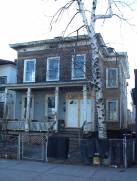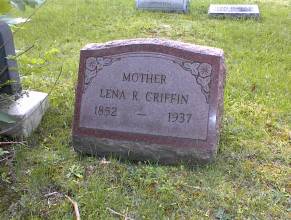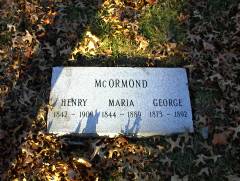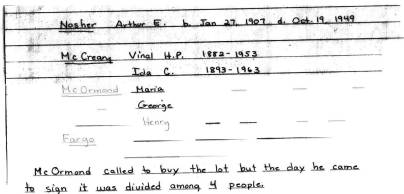Henry McOrmond
1842-1909
Henry McOrmond was born on Christmas day, December 25, 1842, in the North of Ireland. He is the firstborn son of James McOrmond (b: 1819) and Mary Neally, having first arrived in Canada as a small child with his folks, around 1846. The home of his parents, at the time of Henry's birth cannot be verified, to date. Although, innumerous Sources, i.e., Census & Vital records, record "Northern Ireland" as birthplace, there is no known church or vital birth record, to fact. There have been no specific naturalization records found and many sources conflict in certain naturalization facts. Ironically, there exists a microfilming error (omitted images) on the recording of original naturalization records, thus, it cannot be known in certainty if a specific record for him actually exists. To date, none have been found.
Unfortunately, there are not many "essentials" about Henry from an "official-records" perspective. Many of the earliest church records, for example, were lost due to fires in Ireland. However, there is much that is known of him through various other procurements, such as directories, heirlooms, etc. Examples of this can be found through various records indicating his learning in the machinist/toolmaker trade at a young age, and staying with it all his life. It is from this perspective we have a reasonable working knowledge of his history, albeit, somewhat limited. This skilled profession which was passed to each of his sons, who in turn passed some of their handiwork on to their children.
Most folks in the United States embrace their McOrmond history, through Henry's clan. With one thing certain: if you live in the United States, there's a 75% chance you're one of Henry's descendants! That's quite a percentage, given the number of folks out there and number of generations credible of him.
Henry was married twice and had thirteen children. His first marriage was to Maria Bailey having taken place 2 February 1866, in Lowell, Massachusets. Remember, at that time there were no specific laws to register. Folks only did so through a church they may have attended. Many of those are gone, today. It is known Henry remained married to Maria, until her death in 1889. His 2nd marriage was to Lena Roberts on 31 December 1891, in Bridgeport, Fairfield, Connecticut.
Henry grew up with his folks, in Quebec, Canada. In January 1861 at the time of the Canada East Census he was living with them. Corroborating sources indicate shortly after that time, he immigrated to the United States. He lived in Massachusetts on two separate occasions, New York and eventually Connecticut, where he spent the remainder of his life. All through those days, we know Maria was with him.
| Henry immigrated to the U.S. in 1861. The month of Naturalization is, as yet, unknown. According to 1880 & 1900 Census' he was Naturalized. A major omission of microfilmed image records was inadvertently omitted during their creation. This misfortune leads serious consideration of whether Henry's records are existent, at all. What is known in certainty: Henry came to the U.S. during 1861. Source: NARA - National Archives & Records Administration |
Now, Henry
had better credentials than the typical, run-of-the-mill (pun, there) machine
"operator" of the day. He was a trade professional (his membership
in the International Association of Machinists is proof of that). Much of
Henry's work would have been to create the tooling/dies to keep various machines
up and running. This should not be confused with production, per se. A Toolmaker
makes components, tools, dies, etc., to keep the production machines running.
This wouldn't directly make production quotas/piecework standards; rather
this type of job classification should be looked upon more as assistance to
making production quotas possible. It would have been unlikely, that with
his skill, Henry would have worked on some sort of production line. (Compare:
a typical Assembler creating certain product components, and also assembling
them - this is not the norm). With these things considered, Henry's abilities
would have been more technical. A toolmaker compared to a machine operator,
is much like an author of a book compared to its printer or publisher. We
cannot rule out that he may have worked in sweat shops - however, given the
time period, his age, experience and qualifications, Henry was not likely
to be "typical" labor as years passed.
Henry's profession:
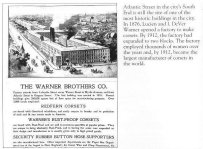
Advert of one of the first companies Henry McOrmond was
employed, after arriving in Bridgeport, CT; he worked for a number of places,
carrying an honorable reputation for his skills as machinist & toolmaker.
We know this from his affiliation with the International Machinists Union
and 1890 Bridgeport City Directory.
| Historical Notes: Right around the time Henry left Clinton, MA, the country was swelling economically. "A new type of corruption developed on Wall Street in New York City, affecting finances all over the country. There was a brief recession that started around 1869, building to the start of worse thing by 1871 - and then came the Panic of '73." I believe Henry saw this coming and decided his best bet was to go to Rochester, NY - as there would have been more people - more opportunity. (He moved to Clinton, MA from Ayer, MA, staying for a very short time, around 1870). "Now, the 'Panic of '73' was just that: a panic - the next 4-5 years was the difficult time, as the country fell into a great depression. In fact, it was called just that: 'The Great Depression.'" |
| "People in our age tend to think of the depression 1930's as "big", and yes, it was - but the Great Depression of the 1870's had far worsening effects. Even the rich folks took it hard. Credit seized up - banks were tight. Creditors wouldn't lend any money to the factory owners. Eventually, the factory owners were running low on funds to pay their workers, so they had to lay them off. With all these laid off workers, there wasn't a large cash flow. Therefore, the demand for goods went down. When the demand for goods went down, there were still more people getting laid off. All of this created a tremendous downward crunch that affected everyone in the worst possible way. Even private owners lacked the funds to respond the enormous needs of the people…" - Sources: Pete Hamill, writer - David McCullough, historian |
Folks like
Henry and other immigrants got hit the hardest because they didn't have their
roots here, very long - and like any tree without strong roots, surviving
a storm was difficult. The number of homeless reached record proportions.
Police stations would open up their basements for the swarms of people that
had nowhere else to go - and even they became overcrowded. Through all of
this, Henry worked. He lived in clean neighborhoods and kept our family intact.
The Great Depression was considered 'over' in 1882. Henry had returned by
then, to Clinton, MA. And as the economy picked up, so did he - moving to
Bridgeport, CT by 1885.
At one point in time or another, each and every one of
Henry's sons worked as Machinists and/or Toolmakers. It seems unlikely that
they would have continued in their father's footsteps, unless the profession
was reasonably profitable. His son, Arthur, remained in the trade after his
study of law and passing of the Connecticut State Bar Exam in the early 1900's.
|
Employment - Some of the places Henry worked in Bridgeport - 1887 - 1899 Henry worked (with son William) at the Ashcroft Manufacturing Co., 1887-8, worked Eaton Cole & Burnham Company, 1889. In 1890, he worked at the Warner Brothers Co. In 1891-1896, he's recorded only as a machinist, but in 1897, the American Oil Co., appears as his employer. In 1898, he's again recorded only as a machinist, 1899 shows he moved to Ansonia. Henry's last employer (before his death in 1909) was the Salts Textile Manufacturing Company. |
Henry also belonged to the I.O.O.F. (Independent Order of Odd Fellows), a wee known community organization.
|
Odd Fellows Temple
(formerly the Second Congregational Church) Sometime afterward the charter expired and a reinstitution was granted in 1869. Since that re-birth Pequonock lodge has been identified closely with the development of the city. In its ranks are to be found within most of the prominent men of the city, to which it has furnished at least eight mayors. Pequonock lodge originally met in the building at Wall and Water streets. Some years later four of gathering in the rooms now occupied by the Public Library.... - From the collection of Duane Brewer. |
Lest we forget, Henry was indeed married and had quite a large family to support. Transcriptions of records from the Church of the Good Shepherd, Clinton Massachusetts, show Henry McOrmond and Maria with seven children, no names listed of children on those pages found - although Maria is listed as baptized. [By Oct. 1880].
Maria Bailey was born 06 December 1844 in Ireland, and died 06 March 1889 in Bridgeport, Fairfield, Connecticut. Her actual DOD Cert was procured from Stratford, CT - this was also considered East Bridgeport, at the time. Many of her family records were recorded between 1874 - 1895 by Church of the Good Shepherd, Clinton Massachusetts, along with those of Henry.
|
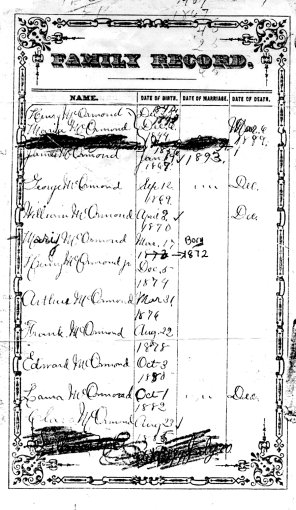
Family Bible Page
Source: Marion Rode -through Irene Hungerford
After Maria's death, Henry married Lena Roberts. Lena Roberts was the daughter of William Roberts and Harriet Cook; born 11 November 1852 in Waterbury, New Haven, Connecticut. She lived for many years, thus more is known about her. The Roberts & Cook families have longtime histories in New Haven County, CT. In fact, her mother was from Humpreysville - now known as Seymour, CT.
|
DOM Cert. - Source information: Marriage - Henry McOrmond The Relevant Date of this Event is:
31 December 1891 |
|
According to the 1910 Census, Lena was the mother of 3 children, with 2 of these children living at the time Census was taken. Quite possible, she and Henry lost a child before he died. No vital record has been found to corroborate with this - although the "unknown" child could have been from a previous marriage.
Lena continued for more than 28 years after Henry died and passed 27 February 1937 in Bridgeport, Fairfield, Connecticut. Her DOD-Cert. incorrectly recorded her DOB as 19 November 1859. In true McOrmond tradition her name incorrectly appears as "Gena" Roberts on (daughter) Alice's DOD Cert.
Lena was buried 02 March 1937, at Lakeview Cemetery, Bridgeport, CT Bridgeport, Fairfield, Connecticut.
Returning
our thoughts to Henry, there are a few notes from our family that should be
noted: With my first contact with his granddaughter, Ginny, she explained
that Henry, in his later years, had a strangulating hernia. It required him
to wear a truss. [I wonder if having worked at Warner Brothers had any influence
on this...?]
Henry McOrmond died 08 January 1909 in Bridgeport Hospital,
Bridgeport, Connecticut. There were, at the time of his death, 2 families
living in the house, at 952 East Main Street. The cause of death recorded
as "Intestinal obstruction".... with duration 5 days - brought on
by: inanition for 3 days His residence at time of death was 952 East Main
Street, Bridgeport, Connecticut. The Obituary transcriptions follow:
| Obit(s): Henry McOrmond
- Henry McOrmond. Henry McOrmond died yesterday at the Bridgeport hospital
aged 67 years. The deceased is survived by a widow, two daughters and
five sons. He was a member of Pequonnock lodge, I.O.O.F., and had been
an Odd Fellow for 30 years. He was also a member of Lodge 30, International
Association of Machinists, and was also a member of Washington Park M.
E. church.- Bridgeport Morning Telegram, Saturday, 09 January 1909 |
| Henry Mcormond aged 67 years, died at
the Bridgeport hospital Friday after an illness of some length. He was
a machinist and a member of the Washington Park Methodist church. He was
also a member of Pequonnock lodge, Independent Order of Odd Fellows, and
had been an Odd Fellow for about 30 years. He also belonged to the International
Association of Machinists, Lodge No. 30. A widow, two daughters and five
sons survive him. - Bridgeport Daily Standard - 11 January 1909. |
Henry was buried on January 9,
1909 at Park Cemetery - 94 Wall Street, Bridgeport, Fairfield, Connecticut
(Current entrance, 620 Lindley St., Section 4, Lot 69). The stone found at
Henry's gravesite was placed in recent years, by Marion and Ron Rode. This
is noteworthy as previous visitations by folks to the gravesite appeared unsuccessful
in finding the stone. Her notes appear to the right.
Personal notes:
I believe one of the peak notations we could make on Henry's life, was how he made himself such a valuable commodity within his trade. Most trade-persons would agree. And most historians would concur: Henry was a success story of the "Immigrant-coming-to-America" dream. Folks in the states need always remember him, as he was one fine Irish-American forefather.

Excerpt of Certified copy of Henry's DOD Cert
Note: The aforementioned strike-through on Line #2, Line # 16
| There other enormous errors found on (son) Arthur's DOD Cert; his mother (Arthur's) is listed as "Sara Bailey" of Ireland and his father as Henry McOrmond of Ireland. The information given to clerk of vital records by informant, Cora, was inaccurate - there are innumerous records to contradict this info. Henry's nationality is listed on his son Arthur's marriage license, as Canadian. [Henry moved to the U.S. from Canada - but was born in Ireland.] - It is now easy to understand how the earliest found information of Henry was inaccurate, i.e., folks believing in a Scot ancestry throughout. |
The preceding image is that of Henry's DOD Cert - containing quite possibly the greatest recorded blunders in our family records! The single strikeout (through mother's name) has been the cause of discrepancies and confusion within many collections of McOrmond family genealogy, worldwide. Indeed, it is the epitome of "invalid information given at time of recording, and its subsequent effects."
Oddly, the informant of much of the information appears to have been son, James. What we have here (in the case of Henry's death), is either James not knowing what his grandmother's name was - or, one very mistaken registrar! Not a tragedy, in itself - but it does give a good indication on the closeness (or lack of) between some of the folks living at the time.
Henry will always be remembered as a hard worker and good provider for his family - his story continues through the lineage of his children - Click Next to continue...
